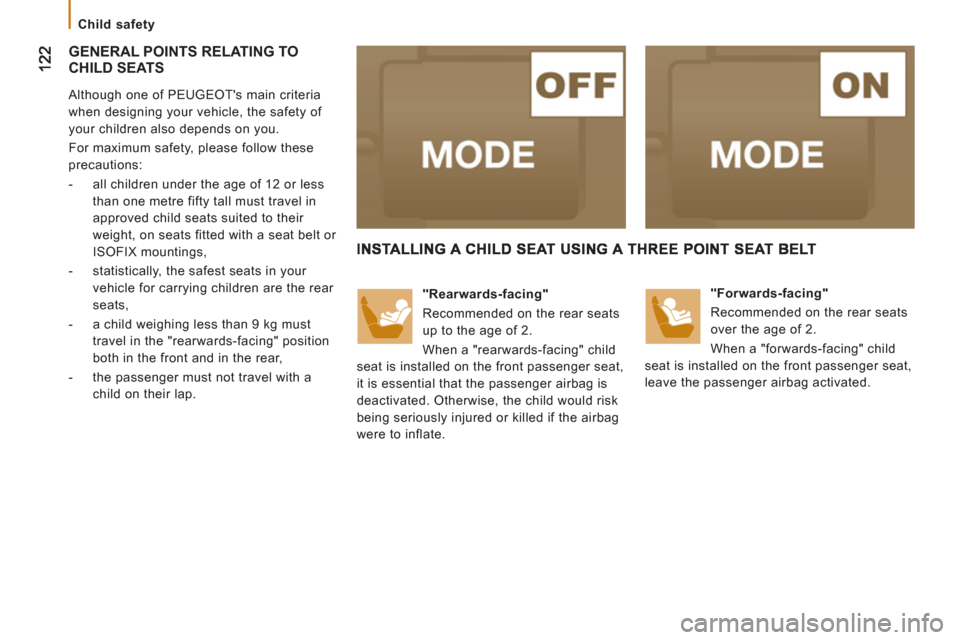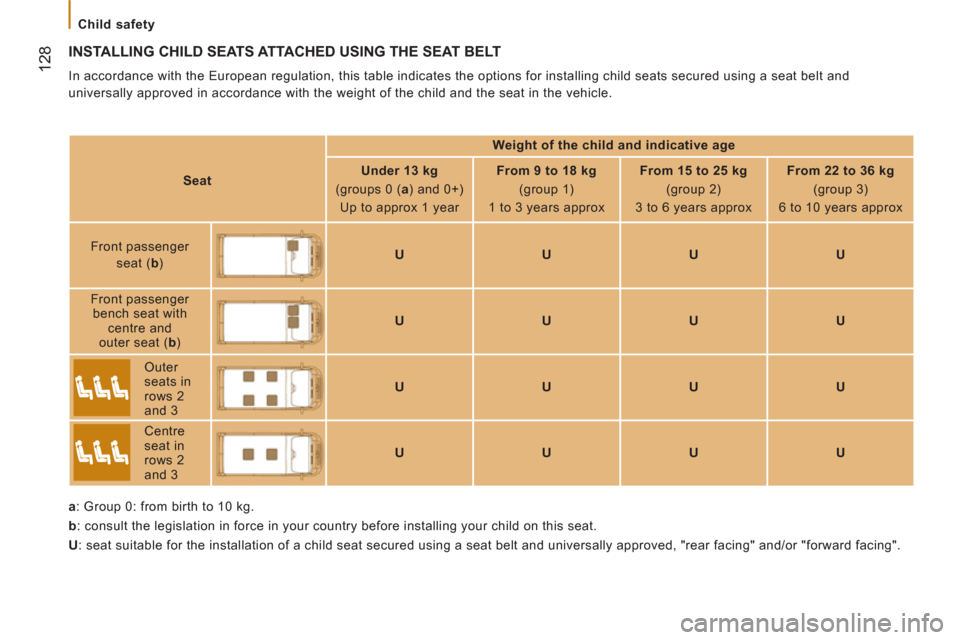Page 5 of 184
3
CONTENTS
Contents
5. SAFETY111-1296. ACCESSORIES130-133
7. CHECKS 134-141
8. QUICK HELP 142-158
9. TECHNICALD ATA159-172A
Parking brake 111Hazard warning lamps 111Horn112ABS 112Emergency brakingassistance 112ASR et ESP 113Fixed speed limiter 115Seat belts 116Airbags 119Deactivating the passenger airbag120Child seats 122ISOFIX seats 124
Towing a trailer 130Roof bars132Other accessories 132
Opening the bonnet 134Under the bonnet 135Levels136Checks 138Fuel 141
Battery142Changing a wheel144Puncture repair kit147Changing a bulb 149Changing a fuse 153Changing a wiper blade157Being towed 158
Dimensions 160Engines 167Weights 168Identifi cation markings 172
10. VISUAL SEARCH 173-180
Exterior 173Instrumentsand controls 174Interior 176Technical data - Maintenance 177
Child seats in the rear.
Page 63 of 184
61
3
EASE OF USE AND COMFOR
T
Seats
Lumbar support
Turn the control.
Seat cushion height adjustment
Lift the handle 1
to raise
or lower the front of the seat.
Lift the handle 2
to raise
or lower the rear of the seat.
Heated seat
Use this control to switch the heating of the
seat on or off.
Seat with variable damping
If your seat is fitted with this system, turn the
control to adjust the level of damping to suit
the driver's weight.
Seat back angle
Turn the control to adjust the angle of
the seat back.
Forwards-backwards adjustment
Lift the control bar, located under the seat,
and adjust to the required position.
Rotating seat
If fitted on your seat, press the control to
rotate the seat by 180°.
Page 124 of 184

Child safety
GENERAL POINTS RELATING TO
CHILD SEATS
Although one of PEUGEOT's main criteria
when designing your vehicle, the safety of
your children also depends on you.
For maximum safety, please follow these
precautions:
- all children under the age of 12 or less
than one metre fifty tall must travel in
approved child seats suited to their
weight, on seats fitted with a seat belt or
ISOFIX mountings,
- statistically, the safest seats in your
vehicle for carrying children are the rear
seats,
- a child weighing less than 9 kg must
travel in the "rearwards-facing" position
both in the front and in the rear,
- the passenger must not travel with a
child on their lap.
"Rearwards-facing"
Recommended on the rear seats
up to the age of 2.
When a "rearwards-facing" child
seat is installed on the front passenger seat,
it is essential that the passenger airbag is
deactivated. Otherwise, the child would risk
being seriously injured or killed if the airbag
were to inflate.
"Forwards-facing"
Recommended on the rear seats
over the age of 2.
When a "forwards-facing" child
seat is installed on the front passenger seat,
leave the passenger airbag activated.
122
Page 130 of 184

Child safety
12
8
INSTALLING CHILD SEATS ATTACHED USING THE SEAT BELT
In accordance with the European regulation, this table indicates the options for installing child seats secured using a seat belt and
universally approved in accordance with the weight of the child and the seat in the vehicle.
Weight of the child and indicative age
Seat
Under 13 kg
(groups 0 ( a
) and 0+)
Up to approx 1 year
From 9 to 18 kg
(group 1)
1 to 3 years approx
From 15 to 25 kg
(group 2)
3 to 6 years approx
From 22 to 36 kg
(group 3)
6 to 10 years approx
Front passenger
seat ( b
)
U
U
U
U
Front passenger
bench seat with
centre and
outer seat ( b
)
U
U
U
U
Outer
seats in
rows 2
and 3
U
U
U
U
Centre
seat in
rows 2
and 3
U
U
U
U
a
: Group 0: from birth to 10 kg.
b
: consult the legislation in force in your country before installing your child on this seat.
U
: seat suitable for the installation of a child seat secured using a seat belt and universally approved, "rear facing" and/or "forward facing".
Page 132 of 184
130
Towing a trailer
TOWING A TRAILER, CARAVAN, BOAT, ETC...
For more information about weights,
refer to the administrative documents
(V5 registration document, ...)
Distribution of loads:
distribute the load in
the trailer so that the heaviest objects are as
close as possible to the axle and the nose
weight is close to the maximum authorised
without, however, exceeding it. Driving advice
A towed vehicle must free wheel: gearbox in
neutral.
Page 134 of 184

Equipment
132
ROOF BARS
To install the transverse roof bars, use the
fixings provided for this purpose. Refer to the "Dimensions" section
of chapter 9 for further information
regarding the length (L1 to L4) and
the height (H1 to H3) of the vehicle. Never exceed the maximum weight of
the vehicle when loaded (GVW).
OTHER ACCESSORIES
These accessories and parts, having been
tested and approved for reliability and
safety, are all adapted to your vehicle.
A wide recommended range and original
parts are offered.
Range of professional equipment
Maximum useful load on the roof bars:
100 kg distributed, regardless of the type of
vehicle.
The roof bars can only be installed on the
H1 and H2 vehicles. Parts and Service technical information
publishes an accessories catalogue offering
various equipment and fittings, such as:
Roof bars for short, medium and long
wheelbase (load retainers for all models).
Foot board, loading roller, step.
Towbar, 7/13 pin, 7/7 pin, 13 pin towbar
harness: trailer towbar which must be fitted
by the PEUGEOT network.
Roof bars for the various heights, additional
roof bar.
Separation partitions, protective floor,
non-slip floor.
Page 170 of 184
168
Weights
WEIGHTS
Dimensions
Model
GVW in kg
L1 H1
330
3 000
333
3 300
L2 H1
333
3 300
335
3 500
L2 H2
330
3 000
333
3 300
335
3 500
L3 H2
330
3 000
335
3 500
435
3 500
440
4 000
L3 H3
330
3 000
335
3 500
435
3 500
440
4 000
L4 H2
335
3 500
L4 H3
435
3 500 Refer to your registration certificate.
In each country, it is imperative that the towed loads permitted by local legislation are complied with. For information regarding your
vehicle's towing possibilities and its gross train weight, contact a PEUGEOT dealer.
The speed of a towing vehicle must not exceed 60 mph (100 km/h) (comply with the legislation in force in your country).
High ambient temperatures may result in a reduction in the performance of the vehicle, to protect the engine. When the ambient
temperature is higher than 37 °C, limit the weight towed.
This table indicates the gross vehicle weight (GVW) according to the dimensions and the vehicle model.
Page 171 of 184
169
9
TECHNI
CAL DAT
A
Weights
*
15 inch wheels.
**
16 inch wheels.
Load transfer
If the towing vehicle has not reached the GVW, it is possible to transfer this weight to the trailer.
In all cases, do not exceed the trailer weight and GTW indicated.
Comply with the towing capacities of your vehicle.
TOWED LOADS
Body type
Engine
With braked trailer
Va n
330
HDi 100
2 000
HDi 120
2 500
HDi 160
2 500
HDi 180
-
333
HDi 100
2 000
HDi 120
2 500
HDi 160
2 500
HDi 180
-
335
HDi 100
2 000
HDi 120
2 500 *
3 000 **
HDi 160
2 500 *
3 000 **
HDi 180
-
435/440
HDi 120
2 500
HDi 160
2 500
HDi 180
-